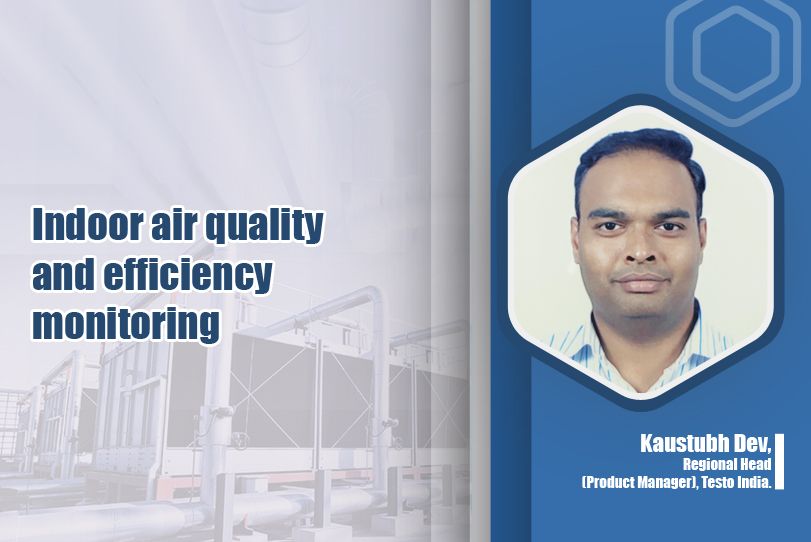Air inside the home can be more polluted than the air outdoors.
Indoor air quality
It is one of the important parameters, which are important in indoor air quality and how to measure those parameters efficiently. First of all, what is indoor air quality and what is the importance of maintaining it! Breathing quality indoor air is critical for good health. Most of us spend a lot of time indoors, either in home, offices or other types of buildings where gases, chemicals and other pollutants can cause headaches, eye irritation and allergies.
Breathing is our first instinct and the most natural thing we do. When we start to think about the air we breathe, and the quality of the air we are breathing. We tend to think about the pollution in the air outdoors, caused by vehicles and factories. However, the air inside the home can be more polluted than the air outdoors. There can be many toxic pollutants and the quality of our indoor air may be polluted, so the people are at risk of respiratory or dermatological conditions due to poor indoor air quality.
Monitoring indoor air quality
It is very important to think about how this may be affecting our health and look at the ways to improve the air indoors. Building a good environment by monitoring indoor air quality can increase the health of occupants, efficiency and productivity of the people working in the building. And for this measurement of these, parameters are the key. Now, various parameters are considered to determine indoor air quality. However, some more important and frequently major parameters are temperature, humidity, CO2, velocity etc.
Changing indoor temperature results in massive discomfort for humans.
To achieve good indoor air quality, it becomes necessary to maintain thermal comfort. The most basic indication of indoor air quality is its temperature, you immediately sense if it’s too hot or too cold. And it immediately affects your sense of well being. Extra heat is a serious risk for your health also; high temperature can cause sufficient humidity.
Nowadays, there is more attention for the strong influence of temperature on the spread and activity of viruses. Viruses that cause respiratory infection often occurs in winter, this may be caused due to reduced resistance of the so called mucous membranes in the nose, when cold air is inhaled, as suitable temperature helps you to prevent the drying of your nasal passage so that you are less susceptible to viruses.
Elevated humidity also promotes growth of various bacteria and moulds indoor. This results in high risk for allergies, fevers and asthma. On the other hand, low humidity may result in sore eyes. Optimum humidity according to national building code should be 40 to 70 percent. In indoor air, maintaining optimum humidity will help achieve good indoor air quality.
So, CO2 is the most commonly present gas which results from the respiration process and it is a by-product of combustion and several metabolic processes in humans. The indoor level of CO2 is generally more than what it is outside. However, the high level of CO2 may stimulate the respiratory issues to cause dizziness, confusions, difficulty to breed etc. Air velocity is one of the most important parameters deciding indoor air quality, if the ventilation rate is very low, and it will result in low indoor air quality.
Air ventilation in public spaces
Proper air ventilation helped us to maintain other relevant parameters within their permissible limit. All the parameters need to be measured at regular intervals, because many reasons like the load keep on changing. With time the external factors keep on changing, like climate and pollution conditions, the equipment gets worn out and there are many other reasons affecting the environment.
Let us take an example of an airport, which is one of the common public spaces where indoor air quality plays a crucial role. Many times we have experienced that multiple flights land in a short time gap. So, suddenly the rush increases as many passengers add on in the premises in addition to those who are waiting to board the flight. So, relevant IAQ parameters like temperature, humidity, and CO2 suddenly increase.
Now, service, quality and passenger satisfaction are the topics of primary interest in the airport industry, even if the reduction of any negative environmental impacts is crucial for airport management. Indoor environmental quality includes indoor thermal environment, lighting, acoustic and air quality. It is of paramount importance for the well being of travellers as well as those who are working in airports. In the majority of airports, we have seen the smoking rooms. A study conducted by the Centre of Disease and Control Prevention found that the average air pollution level directly outside airport smoking lounges was many times higher than in the smoke free airport. So, areas in and around the smoking zone need to be taken care of precisely and the same is the case for the large kitchens and restaurants in and around airports. Now, these spaces are common in other public spaces also other than airports say theatre, malls, and large commercial buildings like BPOs etc.
Now, let us think about HVAC technicians. What features we would like to have in our portable measuring instrument which will make our life easy. So, the first one is to save time for the technician and I would like to have one instrument for multiple parameters. So it will be easy for me if a single instrument can give me all the parameters that a smart multifunctional instrument is required for. It should be easy to operate with minimal buttons. Additionally, it should be user friendly and it should not have a very complex operation.
Parameter measurement by technician Now another thing is, I do not want to carry a pen and a notepad with me to note down the reading. So I should have the instrument which has a memory so that I can add the place of measurement; I can take a reading and store it in memory and afterwards, I can do reporting so that I can make a detailed analysis afterward. The instrument should also be reliable, with a best-in-class accuracy and traceability. So, these are some of the expectations of a person who is taking a lot of HVAC related parameter measurements in their daily routine. So, here are the instruments which can fulfil the expectation of an HVAC technician for an IAQ measurement for the parameter. Many more other parameters this tool can offer with the help of a unique multifunctional instrument, which makes the life of an HVAC technician easy with a multifunctional instrument.
Multiple sensors
So, multiple parameters, multiple sensors can be connected in a single instrument. It can offer parameters like weight as well a temperature etc. Instrument has a probe connection facility for measurement of radiant heat and other parameters like humidity, air velocity, volumetric flow, CO2 measurements and the like. All can be connected; all types of sensor can be connected in a single instrument. Another feature is it has the connectivity like Bluetooth connectivity that is wireless connectivity as well as wired connectivity. So, where there is a restriction of space one can have Bluetooth connectivity. Mainly it helps for measurement of overhead ducts and service force where the limitation of space and their memory is also available with this instrument which enables report generation afterward for detailed analysis.
Also you can use these instruments as a data logger for recording the online data. Now, in daily HVAC technician’s life, they have to measure multiple parameters as well as some calculated parameter also, like while measuring the velocity they also need volumetric flow. So what are they doing normally? They are calculating it afterwards by calculating the area whereas this instrument offers direct calculation of volumetric flow also and averaging like in an airport we have seen the huge ducts where there are multiple openings. So, they have to take averaging so that normally they are doing it manually but with the help of this instrument, we can have it automatically in the instrument.
Equal air distribution is a challenge
Now maintaining IAQ parameters in a permissible limit, air balancing should be done periodically in the large areas like malls and airports. Equal air distribution is a challenge and this can be obtained and checked with the help of air capture. This instrument makes a technician’s life easier as it will give a precise value of velocity and flow at diffusers.
Many technicians are using velocity metres instead of air capture rules, but there is one disadvantage. In anemometer they have to take multiple readings and then they have to average it out whereas air capture gives us a direct average value and it will give you a precise measurement. So for air balancing at large and complex AHUs, an air capture hood is the best solution.
Cookie Consent
We use cookies to personalize your experience. By continuing to visit this website you agree to our Terms & Conditions, Privacy Policy and Cookie Policy.















